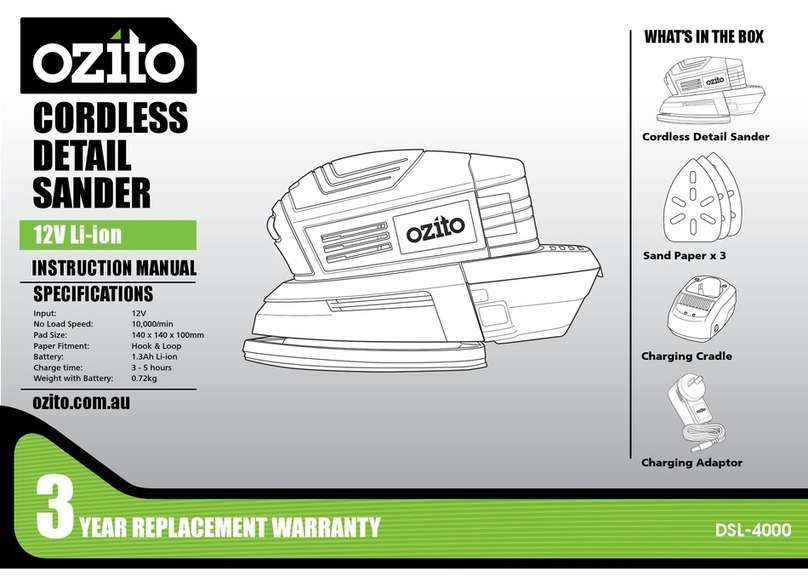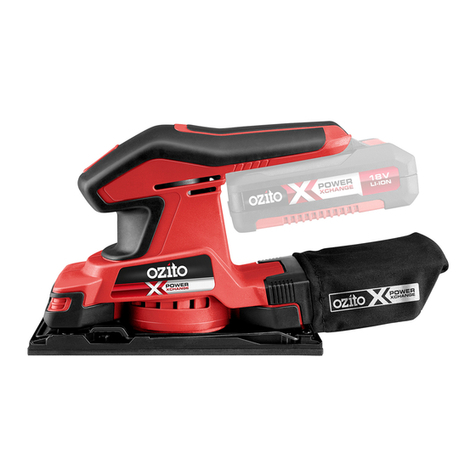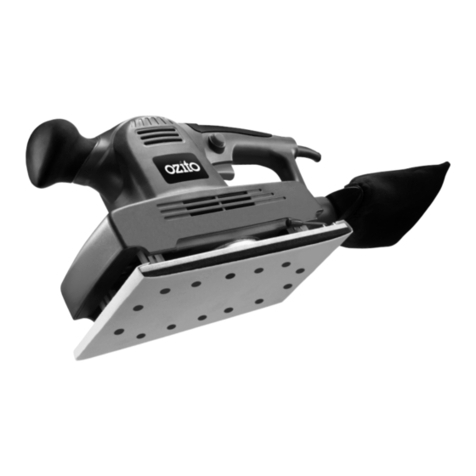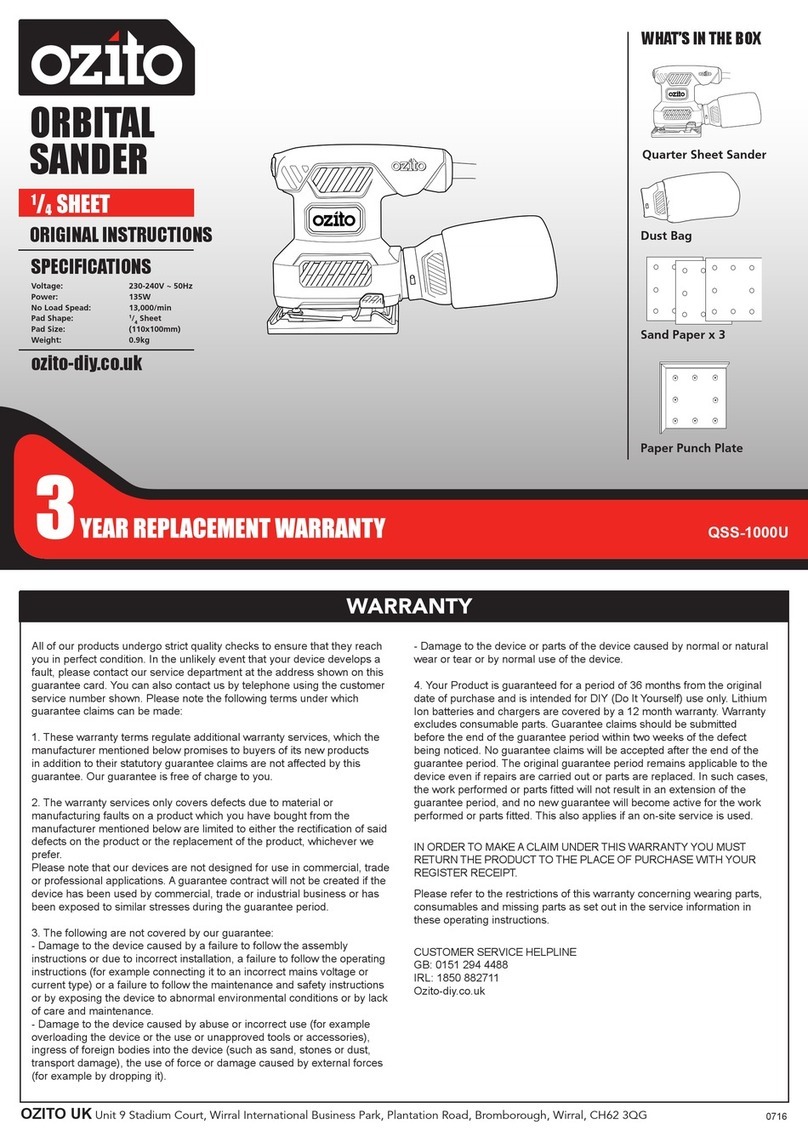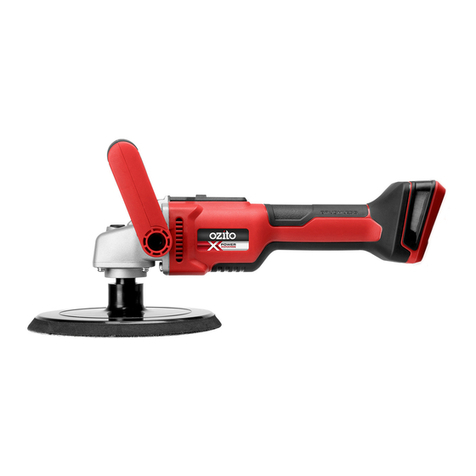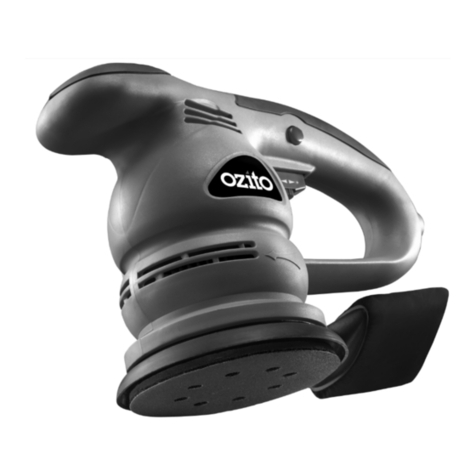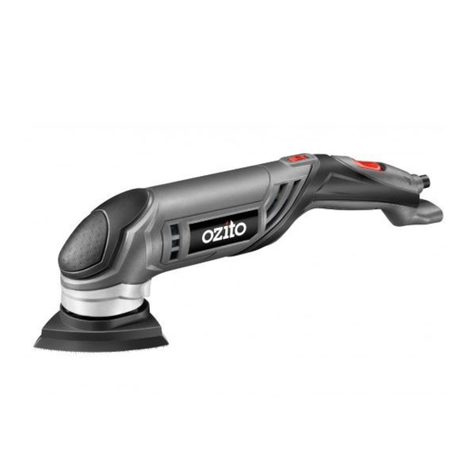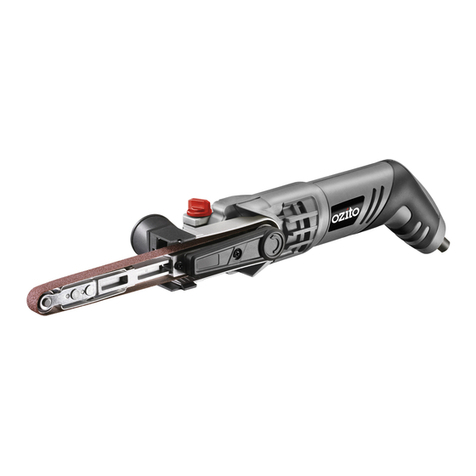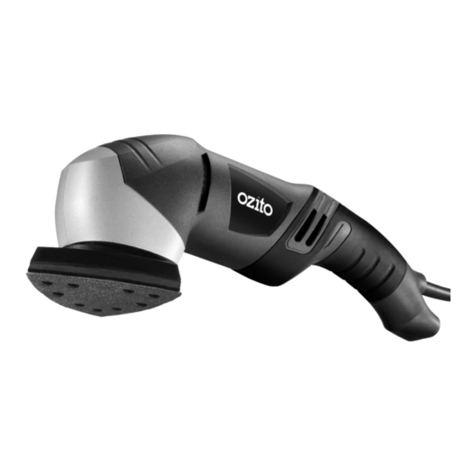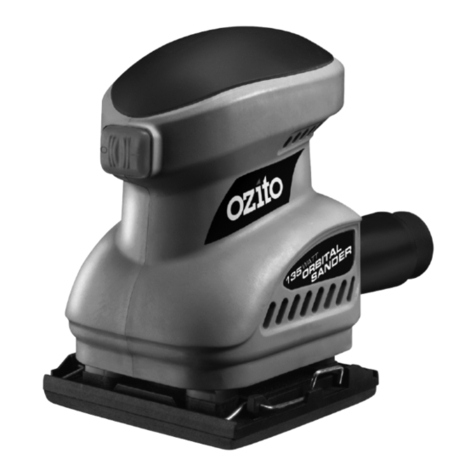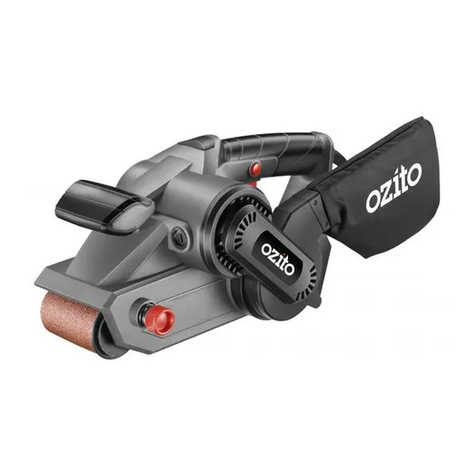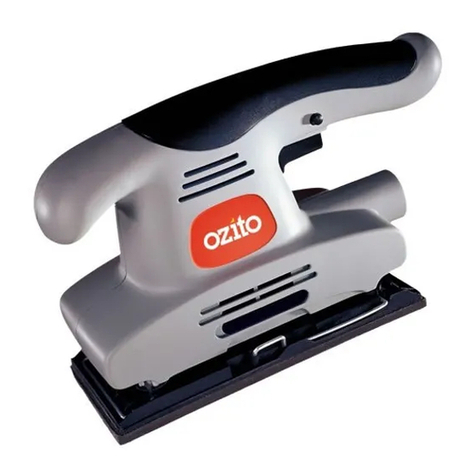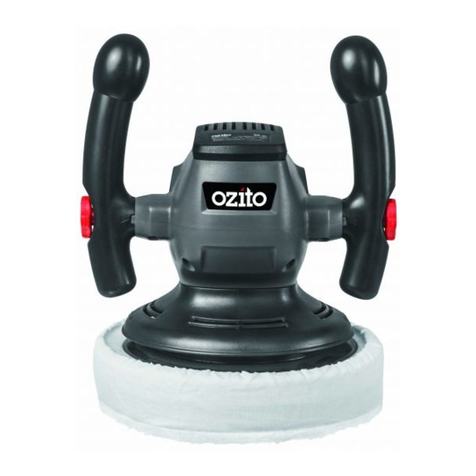
QUARTER SHEET SANDER SAFETY WARNINGS
WARNING!
• Hold power tool by insulated gripping surfaces, because the sanding pad
may contact its own cord. Cutting a “live” wire may make exposed metal parts of
the power tool “live” and could give the operator an electric shock.
Recommendation that the tool always be supplied via a residual current device
with a rated residual current of 30 mA or less.
Unplug the sander before changing accessories. Accidental start-ups may occur if
the sander is plugged in while changing an accessory.
Disposing of dust.Beextremelycarefulofdustdisposal,materialsinneparticle
formmaybeexplosive.Donotthrowsandingdustonanopenre.Spontaneous
combustion,mayintime,resultfromamixtureofoilorwaterwithdustparticles.
Always wear eye protection and a dust mask for dusty applications and when
sanding overhead. Sanding particles can be absorbed by your eyes and inhaled
easily and may cause health complications.
Use special precautions when sanding chemically pressure treated timber,
paint that may be lead based, or any other materials that may contain
carcinogens. A suitable breathing respirator and protective clothing must be worn
by all persons entering the work area. Work should be sealed by plastic sheeting and
persons not protected should be kept out until work area is thoroughly cleaned.
Do not ‘wet sand’ with this sander. Liquids entering the motor housing are an
electrical shock hazard.
Do not use sandpaper intended for larger sanding pads. Larger sandpaper will
extendbeyondthesandingpadcausingsnagging,tearingofthepaperorkick-back.
Extra paper extending beyond the sanding pad can also cause serious lacerations.
WARNING!
Somedustcreatedbypowersanding,sawing,grinding,drillingandother
constructionactivitiescontainchemicalsknowntocausecancer,birthdefectsorother
reproductive harm.
Some examples of these chemicals are:
• Lead from lead-based paints;
• Crystallinesilicafrombricks,cementandothermasonryproducts,and;
• Arsenic and chromium from chemically-treated timber.
Yourriskfromtheseexposuresvaries,dependingonhowoftenyoudothistypeof
work. To reduce your exposure to these chemicals: work in a well ventilated area and
workwithapprovedsafetyequipment,suchasdustmasksthatarespeciallydesigned
tolteroutmicroscopicparticles.
WARNING!Whenusingmains-poweredtools,basicsafetyprecautions,includingthe
following,shouldalwaysbefollowedtoreduceriskofre,electricshock,personalinjuryand
material damage.
Readthewholemanualcarefullyandmakesureyouknowhowtoswitchthetooloinanemergency,
before operating the tool.
Save these instructions and other documents supplied with this tool for future reference.
The charger has been designed for 230V and 240V only. Always check that the power supply corresponds
to the voltage on the rating plate.
Note: The supply of 230V and 240V on Ozito tools are interchangeable for Australia and New Zealand.
This tools is double insulated; therefore no earth wire is required.
Note: Double insulation does not take the place of normal safety precautions when
operating this tool. The insulation system is for added protection against injury resulting from a
possible electrical insulation failure within the tool.
Ifthesupplycordisdamaged,itmustbereplacedbyanelectricianorapowertoolrepairerinorderto
avoid a hazard.
Using an Extension Lead
Alwaysuseanapprovedextensionleadsuitableforthepowerinputofthistool.Beforeuse,inspectthe
extensionleadforsignsofdamage,wearandageing.Replacetheextensionleadifdamagedordefective.
Whenusinganextensionleadonareel,alwaysunwindtheleadcompletely.Useofanextensionlead
notsuitableforthepowerinputofthetoolorwhichisdamagedordefectivemayresultinariskofreand
electric shock.
The power supply for this products charger should be protected by a residual current device (rated at
30mA or less). A residual current device reduces the risk of electric shock.
GENERAL POWER TOOL SAFETY WARNINGS
ELECTRICAL SAFETY
WARNING! Read all safety warnings and all instructions. Failure to follow the
warningsandinstructionsmayresultinelectricshock,reand/orseriousinjury.
Save all warnings and instructions for future reference. The term “power tool” in the warnings
refers to your mains-operated (corded) power tool or battery-operated (cordless) power tool.
1. Work area safety
a. Keep work area clean and well lit. Cluttered or dark areas invite accidents.
b. Do not operate power tools in explosive atmospheres, such as in the presence of ammable
liquids, gases or dust. Power tools create sparks which may ignite the dust or fumes.
c. Keep children and bystanders away while operating a power tool. Distractions can cause you to
lose control.
2. Electrical safety
a. Power tool plugs must match the outlet. Never modify the plug in any way. Do not use any
adapter plugs with earthed (grounded) power tools. Unmodiedplugsandmatchingoutletswill
reduce risk of electric shock.
b. Avoid body contact with earthed or grounded surfaces, such as pipes, radiators, ranges and
refrigerators. There is an increased risk of electric shock if your body is earthed or grounded.
c. Do not expose power tools to rain or wet conditions. Water entering a power tool will increase the
risk of electric shock.
d. Do not abuse the cord. Never use the cord for carrying, pulling or unplugging the power tool.
Keep cord away from heat, oil, sharp edges or moving parts. Damaged or entangled cords increase
the risk of electric shock.
e. When operating a power tool outdoors, use an extension cord suitable for outdoor use. Use of a
cord suitable for outdoor use reduces the risk of electric shock.
3. Personal safety
a. Stay alert, watch what you are doing and use common sense when operating a power tool. Do
not use a power tool while you are tired or under the inuence of drugs, alcohol or medication. A
moment of inattention while operating power tools may result in serious personal injury.
b.Use personal protective equipment. Always wear eye protection. Protective equipment such as dust
mask,non-skidsafetyshoes,hardhat,orhearingprotectionusedforappropriateconditionswillreduce
personal injuries.
c. Prevent unintentional starting. Ensure the switch is in the o-position before connecting to
power source and/or battery pack, picking up or carrying the tool. Carrying power tools with your
ngerontheswitchorenergisingpowertoolsthathavetheswitchoninvitesaccidents.
d. Remove any adjusting key or wrench before turning the power tool on. A wrench or a key left
attached to a rotating part of the power tool may result in personal injury.
e. Do not overreach. Keep proper footing and balance at all times. This enables better control of the
power tool in unexpected situations.
f. Dress properly. Do not wear loose clothing or jewellery. Keep your hair, clothing and gloves away
from moving parts. Looseclothes,jewelleryorlonghaircanbecaughtinmovingparts.
g. If devices are provided for the connection of dust extraction and collection facilities, ensure
these are connected and properly used. Use of dust collection can reduce dust-related hazards.
h. Do not let familiarity gained from frequent use of tools allow you to become complacent and
ignore tool safety principles. A careless action can cause severe injury within a fraction of a second.
4. Power tool use and care
a. Do not force the power tool. Use the correct power tool for your application. The correct power
tool will do the job better and safer at the rate for which it was designed.
b. Do not use the power tool if the switch does not turn it on and o. Any power tool that cannot be
controlled with the switch is dangerous and must be repaired.
c. Disconnect the plug from the power source and/or the battery pack from the power tool before
making any adjustments, changing accessories, or storing power tools. Such preventive safety
measures reduce the risk of starting the power tool accidentally.
d. Store idle power tools out of the reach of children and do not allow persons unfamiliar with the
power tool or these instructions to operate the power tool. Power tools are dangerous in the hands
of untrained users.
e. Maintain power tools.Checkformisalignmentorbindingofmovingparts,breakageofpartsandany
otherconditionthatmayaectthepowertool’soperation.Ifdamaged,havethepowertoolrepaired
before use. Many accidents are caused by poorly maintained power tools.
f. Keep cutting tools sharp and clean. Properly maintained cutting tools with sharp cutting edges are
less likely to bind and are easier to control.
g. Use the power tool, accessories and tool bits etc. in accordance with these instructions, taking
into account the working conditions and the work to be performed. Use of the power tool for
operationsdierentfromthoseintendedcouldresultinahazardoussituation.
h. Keep handles and grasping surfaces dry, clean and free from oil and grease. Slippery handles and
grasping surfaces do not allow for safe handling and control of the tool in unexpected situations.
5. Service
a. Have your power tool serviced by a qualied repair person using only identical replacement
parts. This will ensure that the safety of the power tool is maintained.



